
Introduction
As the Premier League season nears its decisive stage, the battle for European qualification is intensifying. With five teams closely contesting spots from third to sixth place, the race for Champions League, Europa League, and Conference League berths is wide open. Here’s an in-depth look at Manchester City, Nottingham Forest, Newcastle United, Chelsea, and Aston Villa-five contenders vying for the most prestigious continental football next season.
Key Insights
- Manchester City combines elite possession and high-quality attacking with top pressing metrics, but still struggles slightly against counterattacks.
- Nottingham Forest is overperforming based on expected metrics, capitalizing on set-pieces and a compact defensive setup, despite minimal pressing intensity.
- Newcastle United relies on a balanced approach and excels in transitional play, showing strong attacking efficiency and stable defensive metrics.
- Chelsea blends possession-based play with high transition effectiveness, though their defensive fragility on set-pieces remains a concern.
- Aston Villa boasts the league’s highest shot quality (npxG per shot) and strong set-piece efficiency, but needs to improve in disrupting opponents’ buildup play.
1. Manchester City
Manchester City are having a typically strong season, currently sitting third in the league with 1.85 points per game and slightly overperforming their expected points (xPoints), which stand at 1.65 per game (4th best). This slight overachievement reflects their efficiency across key phases of play.
Offensively, City remain one of the most formidable sides in Europe. They score 1.94 goals per game (2nd in the league) with an almost identical xG of 1.9, indicating that their finishing is well-aligned with the quality of chances created. Their ability to dominate inside the box is clear: they register 37.09 touches in the opposition area per match (2nd) and lead the league in expected assists from crosses (0.42 per game). Their npxG per shot of 0.12 is above average, showcasing the high quality of their shot selection.
City’s playing style continues to emphasize possession and territorial dominance. They lead the Premier League in both field tilt (71.33%) and passes per game (602.12), while relying the least on long passes. This highlights their technical control and structured build-up play.
Defensively, City concede 1.3 goals per match (7th), with an xGA of 1.41. While their defensive numbers are solid, transitions remain an area of vulnerability, particularly with an xGA of 0.21 from counter-attacks. However, they compensate with elite pressing metrics-leading the league in both pressing intensity (GPI) and efficiency (GPE). Their control in the final third also limits shots and touches conceded inside their own box.
In summary, Manchester City combine dominant ball control with precise offensive output and elite counter-pressing. Improvements in defending transitions could further solidify their hold on a Champions League spot.
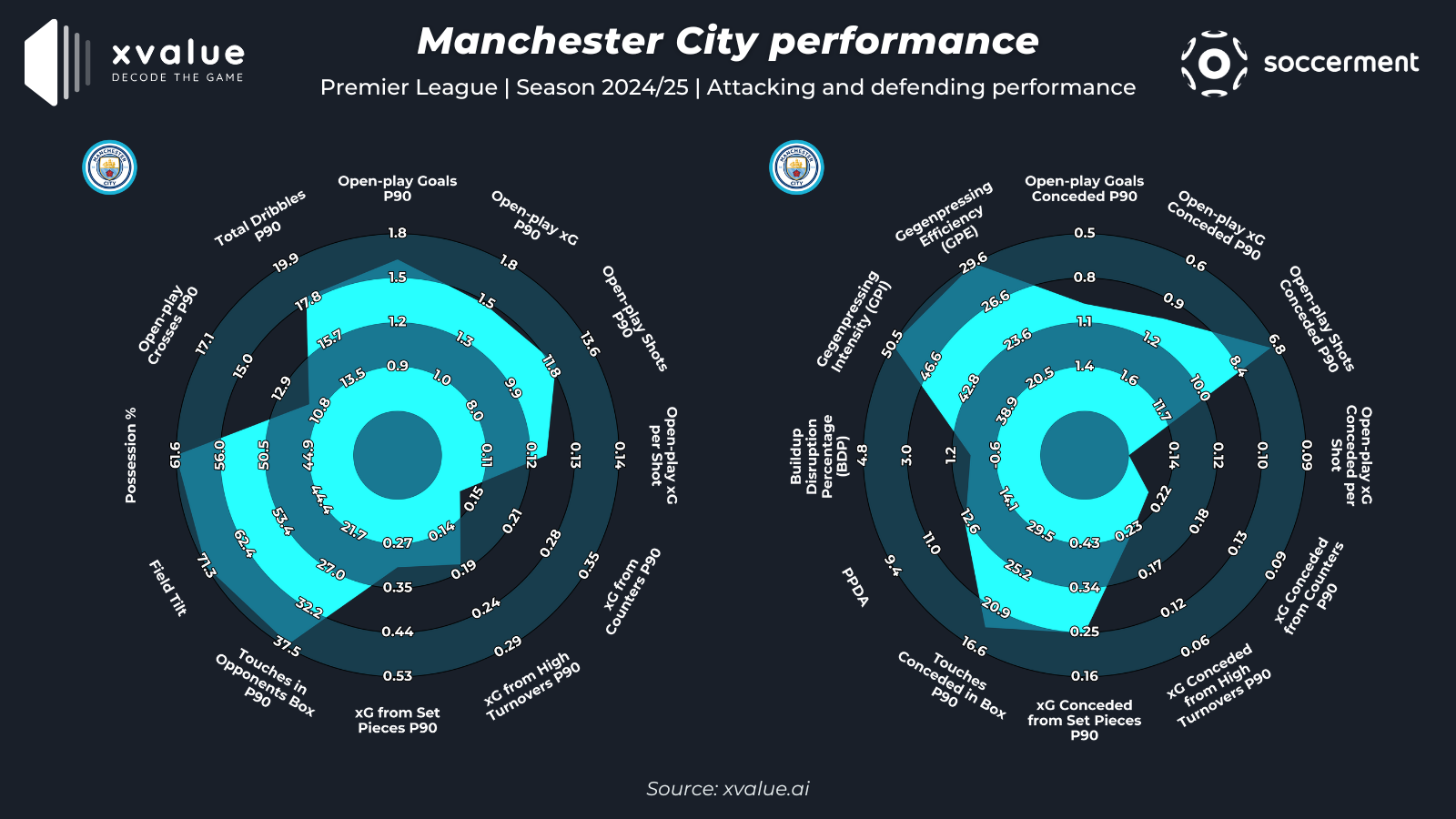
2. Nottingham Forest
Nottingham Forest are among the season’s most surprising performers. Currently 4th with 1.82 points per match, they significantly overperform their underlying metrics, with an xPoints average of just 1.34 (12th). This suggests a level of unsustainable efficiency that has lifted them well above expectation.
Their attack produces 1.58 goals per game with an xG of 1.37, which is a more limited production compared to the other UCL contenders. Set-pieces play a major role in their output, accounting for 0.38 xG per game (5th in the league). They rank only 15th for touches in the opposition box (20.76), pointing to a more selective and opportunistic attacking style.
Forest’s approach is notably direct. They register one of the highest long pass ratios (15.11%) and frequently launch long balls from the goalkeeper (83%), reinforcing their vertical, transition-based strategy.
On the defensive end, Forest are quite effective. They concede just 1.12 goals per game (4th lowest) despite an xGA of 1.39, demonstrating resilience and compactness. They particularly excel at defending against counter-attacks, with only 0.11 xGA per match from such situations.
Their defensive structure is deeper and more passive: with a GPI of 39% and a high PPDA of 15.69, they apply limited pressing and rarely disrupt build-ups high up the pitch (BDP metrics place them among the bottom teams).
In short, Nottingham Forest’s campaign is fueled by clinical execution and solid defensive organization. Their direct playing style may limit volume but maximizes efficiency-though sustaining such performance levels could be a challenge down the stretch.
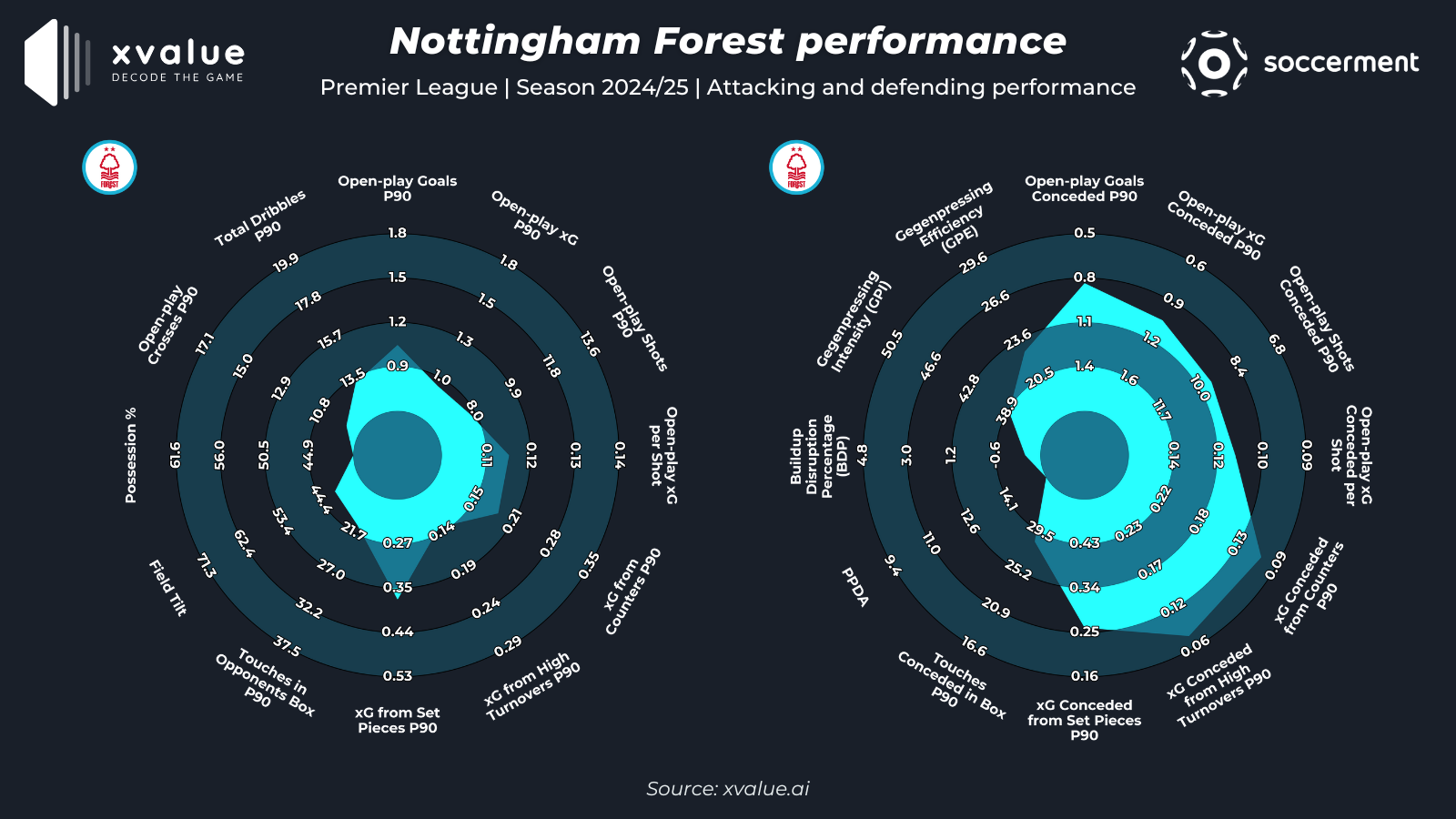
3. Newcastle United
Newcastle United have been consistent throughout the season, currently sitting 5th in the table with 1.79 points per game and slightly outperforming their xPoints (1.56, 7th). Their balanced tactical setup emphasizes both offensive sharpness and defensive organization.
Offensively, Newcastle are effective, scoring 1.88 goals per game (3rd) from an xG of 1.76 (6th). They are especially dangerous on the break, generating 0.26 npxG per match from counter-attacks-the 2nd highest in the league. With a strong open-play xG per shot (0.14), they consistently create high-value chances.
Their playing style reflects equilibrium, with a field tilt of 50% and a moderate use of long balls (9.3%). The balance between direct transitions and structured build-up allows them to adapt to various game states effectively.
Defensively, Newcastle allow 1.33 goals per game, closely aligned with their xGA of 1.44. They perform relatively well against transitions, conceding only 0.15 xGA from counter-attacks. Their pressing intensity is average, with a PPDA of 11.46, showing a willingness to engage defensively without overcommitting.
In essence, Newcastle’s tactical profile is that of a well-rounded team-dangerous in attack, stable in defense, and adaptable across different phases. Their qualification hopes rest on maintaining this consistency against direct rivals.
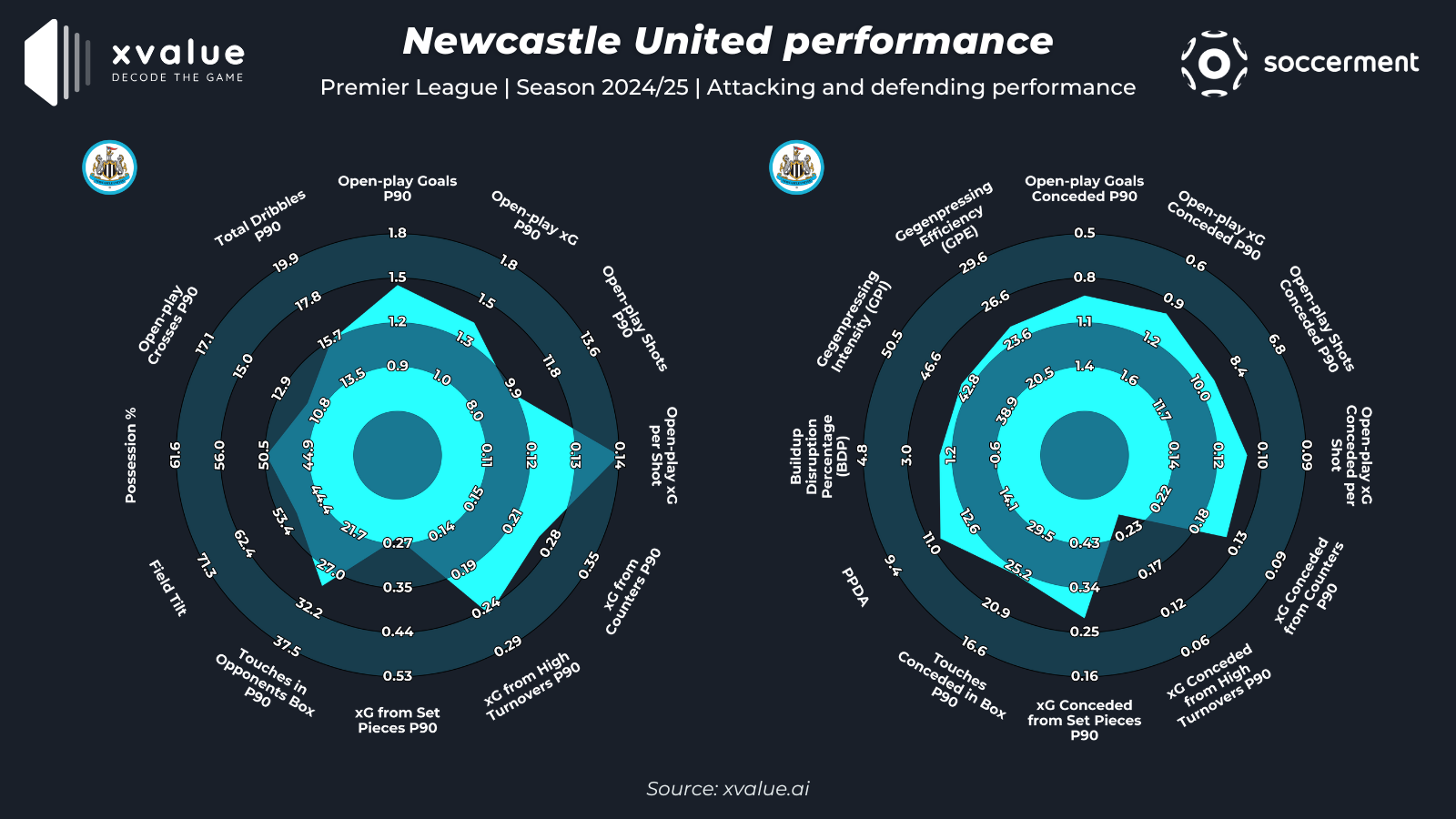
4. Chelsea
Chelsea’s season has been marked by structural improvement and tactical clarity. Currently ranked 7th with 1.73 points per match, their xPoints (1.62, 6th) indicate a minor overperformance. While still developing, their foundation appears increasingly solid.
Offensively, Chelsea score 1.76 goals per game (6th), underperforming slightly relative to their xG of 1.92 (2nd). This underperformance suggests that finishing-rather than chance creation-is limiting their full potential. Nevertheless, their counter-attacking threat is noteworthy, with 11.85% of their xG coming from such scenarios. The team registers 33.03 touches in the box per match (4th), and their high turnover xG of 0.24 per match underscores their pressing-to-attack capability.
Chelsea’s possession-based style is evident in their 62.12% field tilt (4th) and 533.97 passes per game (2nd), while a low long pass ratio (8.59%) reflects their emphasis on short, controlled build-up.
Defensively, they concede 1.21 goals per game from an xGA of 1.4-solid numbers overall. However, they struggle with set-pieces, as 19.66% of their xGA comes from dead-ball situations, one of the highest ratios in the league.
Chelsea’s defensive pressing is efficient without being overly aggressive. Their PPDA of 11.63 and strong BDP value (2.45, 5th) show they are capable of disrupting opponents effectively in deeper areas.
In summary, Chelsea are building a dynamic and proactive identity. Their high-possession, transition-capable style provides a solid base, but improving finishing and defending set-pieces will be key to breaking into the top five.
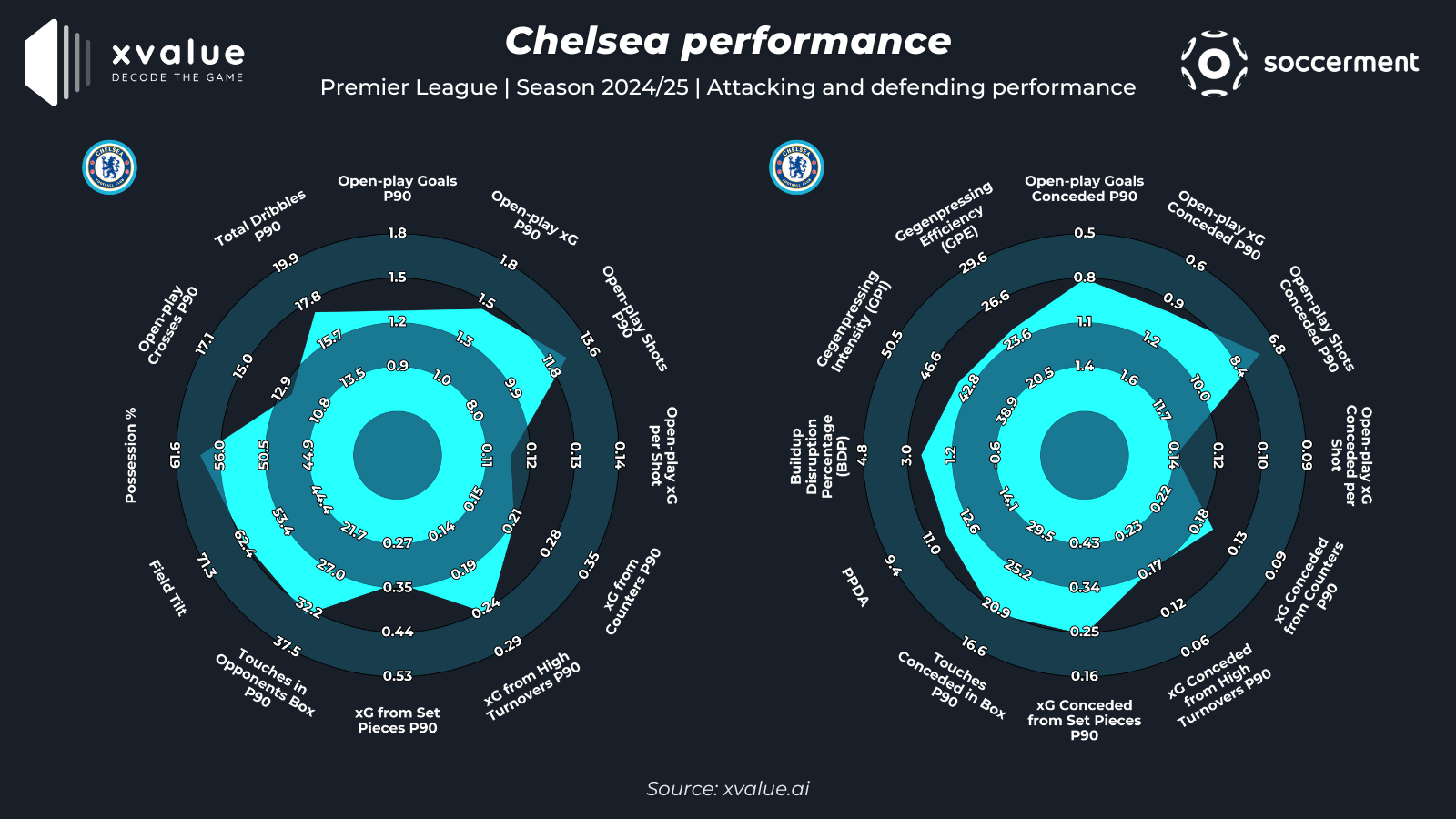
5. Aston Villa
Aston Villa are quietly putting together a strong campaign, averaging 1.73 points per game (equal to Chelsea) and slightly exceeding expectations with an xPoints average of 1.65 (5th). Their performances suggest a well-balanced team with both strengths and clear areas for improvement.
In attack, Villa score 1.48 goals per match from an xG of 1.79, indicating room for growth in finishing efficiency. They lead the league in npxG per shot (0.14), meaning their shot quality is outstanding even if the conversion rate isn’t. A significant portion of their offensive value comes from set-pieces, with 29.2% of their xG originating from dead-ball situations-ranking 3rd overall. Despite this, they’re only 11th in touches in the opposition box, hinting at a more selective offensive approach.
Their offensive style blends possession and directness, with a near-even field tilt (49.45%) and a moderate use of long passes (8.42%).
On the defensive side, Villa concede 1.45 goals per game, closely mirroring their xGA. Set-piece defending is a mixed bag: while 16.57% of their xGA comes from such situations, they rank 2nd in efficiency when defending them. Their pressing efficiency (GPE of 26%) is solid, though their BDP score suggests they struggle more when it comes to disrupting opponents’ build-ups.
To conclude, Aston Villa are a tactically mature side that leverages set-pieces and shot quality effectively. Their balance between construction and verticality suits their squad profile, but sharpening offensive output and improving defensive disruption could make the difference in the final run-in.
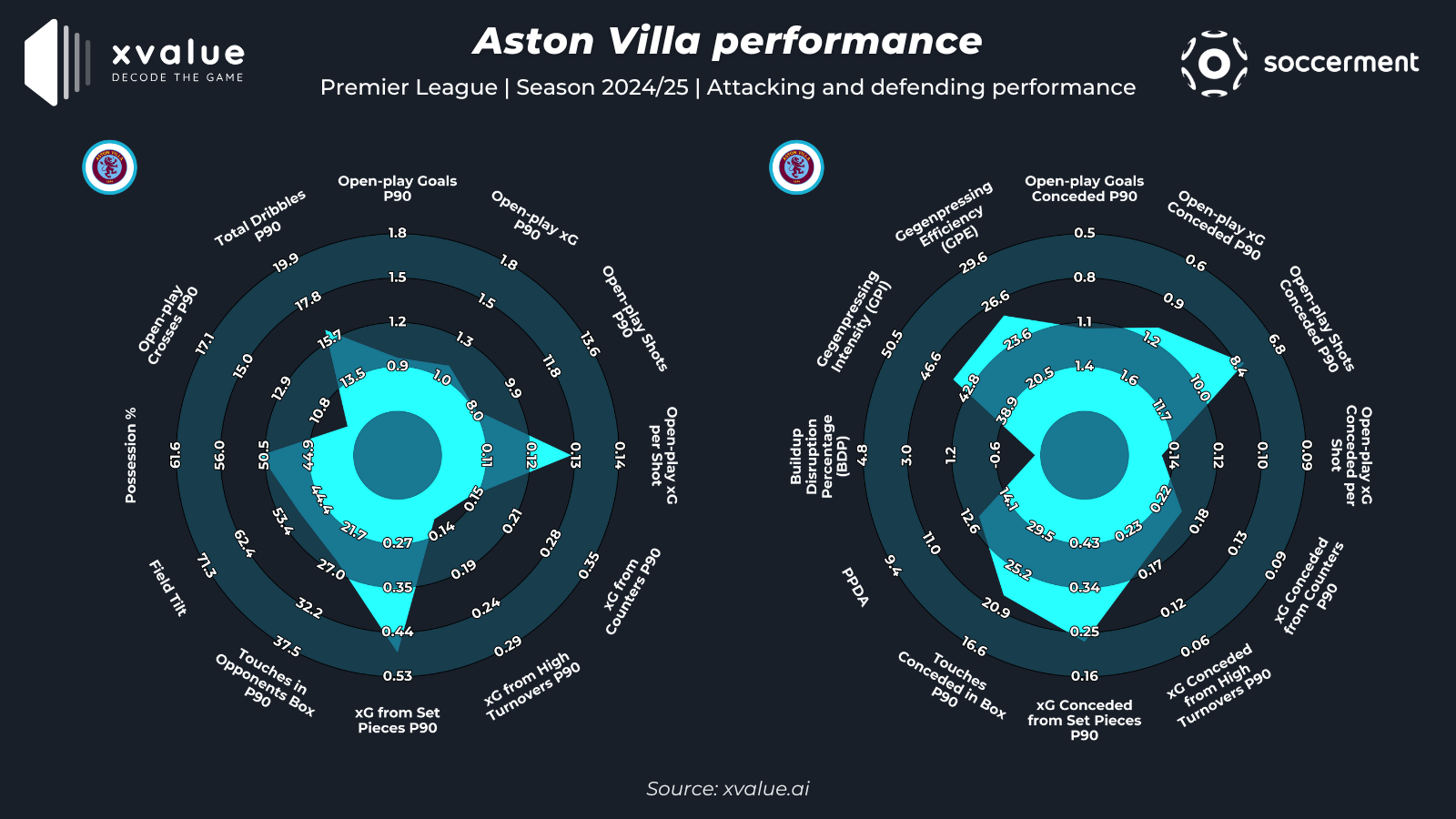
What do you think?
Who do you see securing a spot in next season’s Champions League? And which team could fall short despite the data suggesting otherwise?
Thanks!
Learn more about xvalue, the go-to analytics platform for scouting and match analysis 👉🏻 xvalue.ai
Stay tuned and don’t miss out on the latest updates and insights from Soccerment!


Leave a Reply